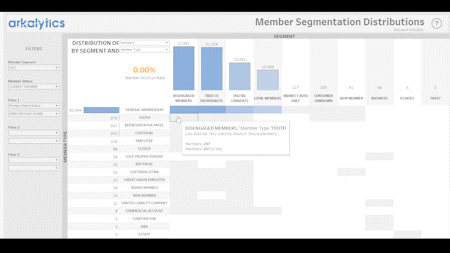Member Segmentation for Credit Unions
by Hannah Barrett, on July 7, 2021
Let's take a look at one of the more advanced Arkalytics dashboards covering the topic of Member Segmentation.
This visualization enables you to categorize like-members based on unique descriptors. In that sense, this dashboard depicts the results of a descriptive analytical model that runs against historical member data.
As a descriptive model, it is the first step in laying the foundation for predictive and prescriptive analytics such as "next best product" recommendation engines and member attrition analysis (predicting when a member might be ready to leave the financial institution for another one).

What is member segmentation?
Member segmentation is a big picture description of your member or customer base. Predictive models and forecasting will not be as accurate if you have not first performed member segmentation based on historical data.
Member segmentation allows you to cluster your customers into groups that share similar behaviors, demographics, and characteristics so that you can customize marketing content or product offers to be more effective and relevant to each specific group.
It is essential that you do proper market segmentation before launching a new product, to ensure that you are marketing it as efficiently and effectively as possible to all potential buyer groups. In practice, this should raise your conversion rates and save you time and money (targeted advertising vs. not) in the long run.
Some common member segment descriptors:
Demographic: This includes basic identification information such as age, gender, income, and education.
Geographic: The location of your member base, broken down as broadly as country/region, or as specific as a town or zip code area.
Behavioral: How are members using your products? In what ways do they prefer to interact with your brand?
Lifestyle: This includes observable habits, hobbies, and preferences of your members.
Loyalty: Is there a grouping of members that are active with your loyalty program? Or you can group members based on a recency, frequency, and monetary score to rank their loyalty with your brand over a certain period of time.
Value: Determine the profitability of each individual member to identify their current and future value to your company. Also known as CLV or 'customer lifetime value' which helps set marketing budgets for advertising campaigns. If you know acquisition costs and CLV, you can adjust your campaigns to be more profitable.
The Benefits
Breaking down a larger target group into more manageable pieces allows your marketing department to work more efficiently. In the process of segmenting, you may discover a new segment that you did not expect, and may in turn alter your marketing efforts accordingly. This process will also help you see what the key motivators are for your members, so you can then brand your product with them in mind.
Geographic intel on your target market may also help you to better understand how, when, and where to optimally distribute your product and promotion. Identify which members may need more attention from your marketing efforts, and which members do not.
If you are interested in learning more about leveraging this technology for your business, reach out to us with the form below:




